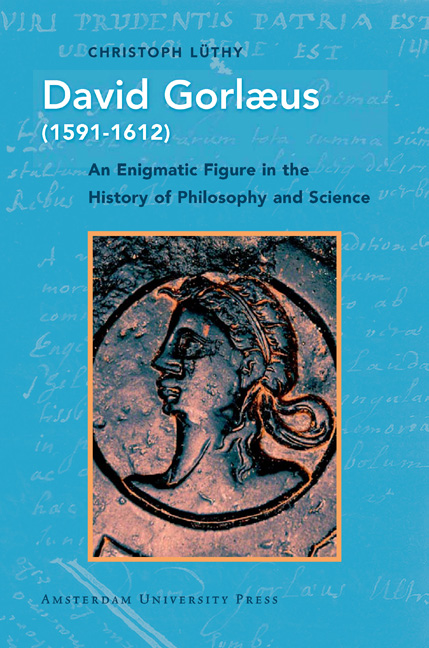Chapter 2 - Gorlæus’ Two Treatises
Published online by Cambridge University Press: 27 January 2021
Summary
In order to be able to appreciate Gorlaeus’ place in the intellectual landscape of the opening years of the seventeenth century, and to assess his possible contribution to the history of philosophy and science, we must first acquaint ourselves with his ideas. Since his works are in Latin, and no one has ever provided a detailed synthesis of their contents, it is inevitable that we ignore the traditional order of presentation and begin with a synopsis of his thought before reconstructing his life.
METHOD OF PRESENTATION
There are different ways in which one can expound the ideas of a philosopher. The most obvious manner of presenting Gorlaeus’ philosophy is by condensing the arguments of his two works into a single paraphrase. This is because the Exercitationes philosophicae (printed in 1620) and the Idea physicae (printed in 1651) bear a straightforward relation to each other. The 352-page Exercitationes tries to anchor Gorlaeus’ natural philosophy in an ontology, or philosophy of being. By contrast, the scope of the 76-page short Idea is more straightforward and simple: it limits itself to the domain of natural philosophy (physica) and anticipates the doctrines of natural philosophy of the latter parts of the Exercitationes. The relation between the two books can be gauged by a comparison of their thematic structure. The Idea physicae is composed of thirteen chapters, which rehearse the traditional succession of themes in courses of natural philosophy:
Ch. 1: Which treats of the constitution of physics and nature
Ch. 2: On (what are commonly called) the internal principles of nature
Ch. 3: On the external principles of natural things
Ch. 4: On composition, quantum and the continuum
Ch. 5: On motion, place and time
Ch. 6: On the heavens
Ch. 7: On the elements and mixture
Ch. 8: On meteors
Ch. 9: On metals, the soul, life and death
Ch. 10: On the vegetative soul
Ch. 11: On the sentient soul
Ch. 12: On the main qualities affecting the senses
Ch. 13: On the human soul
Although in his Idea physicae Gorlaeus redefines a host of Aristotelian doctrines, its structure nevertheless mirrors that of traditional textbooks; these in turn follow the canonical order of the Aristotelian works: from the Physics by way of De caelo, De generatione et corruptione and Meteorology to the treatise De anima.
- Type
- Chapter
- Information
- David Gorlaeus (1591–1612)An Enigmatic Figure in the History of Philosophy and Science, pp. 25 - 60Publisher: Amsterdam University PressPrint publication year: 2012



